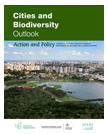According to the Cities and Biodiversity Outlook, 60% of land projected to become urban by 2030 has yet to be built on, presenting a major opportunity to greatly improve global sustainability by promoting low-carbon, resource-efficient urban development that can reduce adverse effects on biodiversity and improve quality of life.
 16 October 2012: A new report, titled “Cities and Biodiversity Outlook,” was produced by the Secretariat of the Convention on Biological Diversity (CBD), together with the Stockholm Resilience Centre (SRC) and Local Governments for Sustainability (ICLEI) and released on the sidelines of the eleventh meeting of the Conference of the Parties (COP 11) to the CBD, convening from 8-19 October 2012, in Hyderabad, India.
16 October 2012: A new report, titled “Cities and Biodiversity Outlook,” was produced by the Secretariat of the Convention on Biological Diversity (CBD), together with the Stockholm Resilience Centre (SRC) and Local Governments for Sustainability (ICLEI) and released on the sidelines of the eleventh meeting of the Conference of the Parties (COP 11) to the CBD, convening from 8-19 October 2012, in Hyderabad, India.
The Cities and Biodiversity Outlook draws on contributions from over 123 international scientists and represents the first global analysis of how projected patterns of urban land expansion will impact biodiversity and ecosystems. According to the Outlook, 60% of land projected to become urban by 2030 has yet to be built on, presenting a major opportunity to greatly improve global sustainability by promoting low-carbon, resource-efficient urban development that can reduce adverse effects on biodiversity and improve quality of life.
The assessment provides examples of how urban areas can play a central role in achieving the Aichi Biodiversity Targets, and highlights successful initiatives by cities, local authorities and sub-national governments in both developed and developing countries. [UNEP Press Release] [Publication: Cities and Biodiversity Outlook]